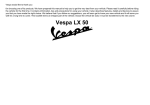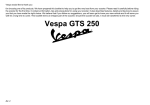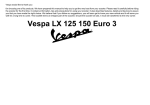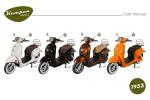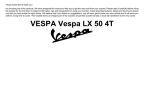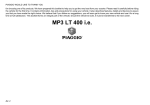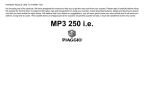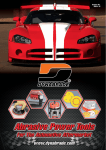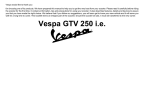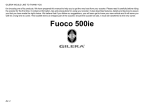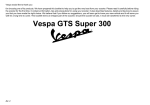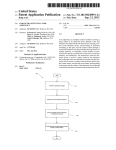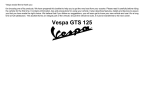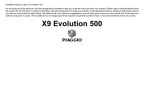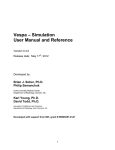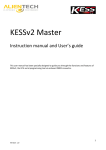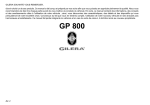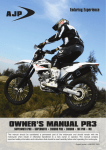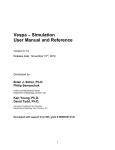Download Vespa LXV 50 - Vespa Club Polska
Transcript
Vespa would like to thank you for choosing one of its products. We have prepared this manual to help you to get the very best from your scooter. Please read it carefully before riding the scooter for the first time. It contains information, tips and precautions for using your scooter. It also describes features, details and devices to assure you that you have made the right choice. We believe that if you follow our suggestions, you will soon get to know your new vehicle and it will serve you well for a long time to come. This booklet forms an integral part of the scooter; should the scooter be sold, it must be transferred to the new owner. Vespa LXV 50 The instructions given in this manual are intended to provide a clear, simple guide to using your scooter; this booklet also details routine maintenance procedures and regular checks that should be carried out on the vehicle at an authorised Dealer or Service Centre. The booklet also contains instructions for simple repairs. Any operations not specifically described in this manual require the use of special tools and/or particular technical knowledge: to carry out these operations refer to any authorised Dealer of Service Centres. 2 Personal safety Failure to completely observe these instructions will result in serious risk of personal injury. Safeguarding the environment Sections marked with this symbol indicate the correct use of the vehicle to prevent damaging the environment. Vehicle intactness The incomplete or non-observance of these regulations leads to the risk of serious damage to the vehicle and sometimes even the invalidity of the guarantee. The signs that you see on this page are very important. They are used to highlight those parts of the booklet that should be read with particular care. As you can see, each sign consists of a different graphic symbol, making it quick and easy to locate the various topics. 3 4 INDEX VEHICLE...................................................................................... Dashboard................................................................................ Analogue instrument panel....................................................... Key switch................................................................................. Locking the steering wheel.................................................... Releasing the steering wheel................................................ Switch direction indicators........................................................ Horn button............................................................................... Light switch............................................................................... Start-up button.......................................................................... The saddle................................................................................ Opening the saddle............................................................... Keys.......................................................................................... Identification.............................................................................. Rear top box opening................................................................ USE.............................................................................................. Checks...................................................................................... Refuelling.................................................................................. Tyre pressure............................................................................ Running in................................................................................. Starting up the engine............................................................... Difficult start up......................................................................... Stopping the engine.................................................................. Catalytic silencer....................................................................... Automatic transmission............................................................. Safe driving............................................................................... MAINTENANCE........................................................................... Hub oil level.............................................................................. Tyres......................................................................................... Spark plug dismantlement........................................................ Removing the air filter............................................................... Secondary air system............................................................... Intake plug................................................................................ 7 8 9 10 10 10 11 11 12 12 12 13 13 14 14 15 16 16 18 18 19 20 21 21 22 22 25 26 27 28 29 29 30 Checking the brake oil level...................................................... Battery....................................................................................... Checking the electrolyte level................................................ Long periods of inactivity.......................................................... Fuses........................................................................................ Front light group........................................................................ Headlight adjustment............................................................. Front direction indicators........................................................... Rear optical unit........................................................................ Rear turn indicators................................................................... Rear-view mirrors...................................................................... Idle adjustment.......................................................................... Front disc brake........................................................................ Rear drum brake....................................................................... Puncture.................................................................................... Periods of inactivity................................................................... Cleaning the vehicle.................................................................. TECHNICAL DATA...................................................................... Kit equipment............................................................................ SPARE PARTS AND ACCESSORIES........................................ Warnings................................................................................... PROGRAMMED MAINTENANCE............................................... Scheduled maintenance table................................................... Selènia Moto Rider................................................................... 5 31 32 33 33 34 36 37 38 38 39 39 40 40 41 42 42 42 49 52 53 54 55 56 64 6 Vespa LXV 50 Chap. 01 Vehicle 7 01_01 Dashboard (01_01) A = Starter button B = Throttle grip 1 Vehicle C = Front brake lever D = Instrument panel E = Light switch 8 1 Vehicle F = Front brake lever G = Turn indicator switch H = Horn button 01_02 Analogue instrument panel (01_02) A = Fuel gauge 9 B = High-beam warning light C = Turn indicator warning light D = Odometer E = Speedometer F = Low fuel warning light G = Low oil pressure warning light H = Headlight warning light Key switch (01_03) LOCK = Ignition disabled, extractable key, steering lock engaged front glove-box locked. OFF = Ignition disabled, extractable key, steering lock disengaged, front glove-box unlocked. ON = Starter position, antitheft device disabled, non-extractable key, glove-box unlocked. 01_03 Locking the steering wheel Turn the handlebar to the left (as far as it will go), turn the key to position «LOCK» and remove the key. CAUTION 1 Vehicle DO NOT TURN THE KEY TO «LOCK» OR «OFF» WHILE RIDING. Releasing the steering wheel Reinsert the key and turn it to «OFF». 10 DO NOT TURN THE KEY TO «LOCK» OR «OFF» WHILE RIDING. Switch direction indicators (01_04) To set the left turn indicators flashing, move lever «B» to the left; to set the right turn indicators flashing, move it to the right. The lever automatically returns to the central position and the indicators remain on. To turn the indicators off, press the lever towards the switch. 01_04 Horn button (01_05) Horn button «E» 01_05 11 1 Vehicle CAUTION Light switch (01_06) 1 = High beam and side light 2 = Low beam and side light 3= High-beam light passing mode 01_06 Start-up button (01_07) To start the engine, press the starter button, «P», after pulling either one of the two brake levers. 01_07 The saddle 1 Vehicle Saddles fitted to this scooter are upholstered in Authentic Leather, and are a stylish accessory to emphasise an already exclusive product such as your Vespa. As leather is a natural and vivid material, it tends to get "very opaque" aspect as time goes by, an aspect typical of Authentic Leather. This product may also show characteristic undertones and strains. To care and maintain the features of the saddle through time, follow these tips: Do not expose it to weather changes, when the scooter is parked protect it with the waterproof cover supplied and stored under the saddle. 01_08 12 In case of forced and prolonged exposure to water, dry the saddle far from any heat source, do not to use alcohol, solvent-based products and pay special care when refuelling. If the saddle gets stained, wipe the area and if necessary wash it with lukewarm water and neutral soap. To prevent the waterproof cover from being taken away when the scooter is left unattended, fasten it with hook next to the saddle hinge. Opening the saddle (01_08) Insert the key into the saddle lock «A», turn it anticlockwise and tip the saddle forward. Keys (01_09) The vehicle is supplied with two keys (one spare) which serve to start the engine and unlock the saddle compartment. The keys are accompanied by a tag marked with the identification code to be quoted when ordering duplicates. WARNING WE RECOMMEND KEEPING THE DUPLICATE KEY TOGETHER WITH ITS CODE IN A SAFE PLACE AND NOT ON THE VEHICLE 01_09 13 1 Vehicle Periodically, especially during rainy seasons, apply commercially available waterproofing products (footwear spray). Do not apply shoe polish or wax on the saddle so as not to stain your clothes. Identification (01_10, 01_11) The identification numbers consist of a prefix stamped on the chassis and on the engine, followed by a number. They should always be given when requesting spare parts. We recommend that you check that the prefix and chassis number stamped on the vehicle correspond with those in the vehicle documents. CAUTION 01_10 BE REMINDED THAT ALTERING IDENTIFICATION REGISTRATION NUMBERS CAN LEAD TO SERIOUS PENAL SANCTIONS (IMPOUNDING OF THE VEHICLE, ETC.). 01_11 Rear top box opening 1 Vehicle Turn the key to the position«OFF». Then press it. With the key is in «LOCK» the glovebox is locked. 14 Vespa LXV 50 Chap. 02 Use 15 Checks Before using the vehicle, check: 1. That the petrol tank and oil reservoir are full. 2. The oil level in the rear hub. 3. That the tyres are correctly inflated. 4. That the headlight, rear light and turn indicators are in working order. 5. That the front and rear brakes are in working order. 6. The fluid level in the brake pump reservoir. Refuelling (02_01, 02_02) Fill fuel tank «A» with unleaded petrol with a minimum octane rating of 95. The low fuel warning light on the instrument panel turns on to signal low fuel (see the "Control Panel" section). Top up oil tank «B» using recommended oil. The oil warning light on the instrument panel turns on to signal oil minimum level (see the "Control Panel" section). Should this warning light turn on, the oil tank should be topped-up at the following refuelling and in any case before travelling another 150 km. 02_01 When turning the key «ON», the oil warning light turns on for a few seconds indicating the correct functioning of the bulb and oil reserve circuit. If the warning light fails to come on, it is faulty. Should this happen, contact an Authorised Piaggio Service Centre. 2 Use CAUTION 02_02 SHUT OFF THE ENGINE BEFORE REFUELLING WITH PETROL. PETROL IS HIGHLY FLAMMABLE. DO NOT LET PETROL SPILL FROM THE TANK OR WHILE REFUELLING 16 2 Use CAUTION DO NOT BRING NAKED FLAMES OR CIGARETTES NEAR THE MOUTH OF THE FUEL TANK: FIRE HAZARD. ALSO AVOID INHALING HARMFUL VAPOURS. IMPORTANT: NEVER EMPTY THE MIXER OIL RESERVOIR. CAUTION THE USE OF OILS AND SPARK PLUGS OTHER THAN THOSE RECOMMENDED CAN SHORTEN THE LIFE OF THE ENGINE. Recommended products AGIP CITY HI TEC 4T Oil to lubricate flexible transmissions (brake, throttle control and mixer, odometer) Oil for 2-stroke engines: SAE 5W-40, API SL, ACEA A3, JASO MA Characteristic oil mixer tank Plastic, capacity ~ 1.2 l Topping up mixer oil tank Topping up oil tank: 0.5 ÷ 0.7 l Fuel tank capacity ~ 8.5 l (2 l of which is reserve) 17 Tyre pressure CAUTION TYRE PRESSURE SHOULD BE CHECKED WHEN TYRES ARE COLD.INCORRECT TYRE PRESSURE CAUSES ABNORMAL TYRE WEAR AND MAKES RIDING DANGEROUS. TYRES MUST BE REPLACED WHEN THE TREAD REACHES THE WEAR LIMITS SET FORTH BY LAW. Characteristic Front tyre pressure 1.6 bar Rear tyre pressure 2 bar Rear tyre pressure - driver and passenger 2.2 bar Running in 2 Use WARNING DURING THE FIRST 1000 KM DO NOT RIDE THE VEHICLE OVER 80% OF ITS MAXIMUM SPEED. AVOID TWISTING THE THROTTLE GRIP FULLY OR KEEPING A CONSTANT SPEED ALONG LONG SECTIONS OF ROAD. AFTER THE FIRST 1000 KM, GRADUALLY INCREASE SPEED UNTIL REACHING THE MAXIMUM PERFORMANCE. 18 The scooter is fitted with automatic transmission with a regulator and centrifugal clutch. Therefore always start the engine with the throttle at a minimum; to start-off from still, progressively twist the throttle grip. The vehicle is equipped with a fuel valve and a starter that switch on automatically as soon as the engine is started. 02_03 In order to start the engine, it is necessary to pull either the rear brake lever "B" or the front brake lever "C", before pressing the starting button, "A ", so as to disengage the safety switches. 1: Put the motorscooter on its stand "E"; check that the rear tire is off the ground. 2: Keep the throttle closed. 3: Insert the key into the ignition switch, "D", and turn to the ON position. 4: Push the starter button «A» after pulling the rear brake lever «B» or the front brake lever «C». CAUTION DO NOT CARRY OUT THESE OPERATIONS IN CLOSED AREAS SINCE EXHAUST GASES ARE TOXIC. CAUTION DUE TO THE HIGH TEMPERATURES THE CATALYTIC CONVERTER CAN REACH, ALWAYS TAKE CARE, WHEN PARKING THE SCOOTER, THAT THE EXHAUST DOES NOT COME INTO CONTACT WITH FLAMMABLE MATERIALS, TO AVOID SERIOUS BURNS. 19 2 Use Starting up the engine (02_03) Difficult start up (02_04) If there is a problem you can follow the instructions below: 1. Engine flooded. Place the vehicle on its centre stand and check that the rear wheel is off the ground. Open the throttle fully and press the starter button for five seconds and then stop for five seconds. If the engine does not start after a few attempts, let the engine sit for a few minutes and then repeat the above operations. In any case do not operate the starter motor longer than 20" in an attempt to start the engine. 02_04 2. Battery or starter motor inefficiency. Place the scooter on its stand "E"; make sure that the rear wheel is off the ground, turn the key switch «D» to «ON» and use the kick-starter «F». If the engine is flooded, twist the throttle grip fully open while operating the kick-starter. 3. Empty fuel tank. After refuelling the scooter, start the engine by pressing the starter button «A» with the throttle at a minimum to provide maximum aspiration for the tap. If the vehicle fails to start even after carrying out the steps described above, contact an Authorised Service Centre. CAUTION ALWAYS PLACE THE VEHICLE ON ITS STAND BEFORE KICK STARTING. WARNING 2 Use TAMPERING MAY CAUSE SERIOUS ENGINE MALFUNCTION. 20 Stop acceleration, then turn the key switch "D" to "OFF " to turn off the engine (extractable key). CAUTION 02_05 DUE TO THE HIGH TEMPERATURES THE CATALYTIC CONVERTER CAN REACH, ALWAYS TAKE CARE, WHEN PARKING THE SCOOTER, THAT THE EXHAUST DOES NOT COME INTO CONTACT WITH FLAMMABLE MATERIALS, TO AVOID SERIOUS BURNS. Catalytic silencer CAUTION TAMPERING WITH THE CATALYTIC MUFFLER MAY CAUSE SEVERE DAMAGE TO THE ENGINE . CAUTION WHEN PARKING THE VEHICLE, DUE TO THE HIGH TEMPERATURES THE CATALYTIC CONVERTER CAN REACH, ALWAYS BE CAREFUL THAT THE MUFFLER DOES NOT COME INTO CONTACT WITH FLAMMABLE MATERIALS, TO AVOID SERIOUS BURNS. 21 2 Use Stopping the engine (02_05) CAUTION DO NOT SWITCH OFF THE ENGINE WHILE THE VEHICLE IS MOVING. UNBURNED FUEL COULD ENTER THE CATALYTIC CONVERTER AND BURN, CAUSING IT TO OVERHEAT AND POSSIBLY DESTROYING IT. Automatic transmission To ensure simple, pleasurable riding, the vehicle is equipped with automatic transmission with regulator and centrifugal clutch. The system is designed to give the best possible performance in terms of both acceleration and consumption, on level ground and uphill, thanks to the adjustments made to engine speed and transmitted torque. If you have to stop on an uphill slope (traffic lights, traffic jam, etc.) only use the brake to keep the vehicle still, leaving the motor running at idling speed. Using the motor to keep the vehicle still can cause the clutch to overheat. This problem is due to the friction of the clutch parts on the clutch bell. It is therefore recommended to avoid conditions of prolonged clutch slippage leading to clutch overheating (for example, as well as the situation described above, riding uphill fully laden on steep slopes or starting off on slopes greater than 25%, etc.): 1. Do not continue riding in such conditions. 2. Let the clutch cool down with the motor at idling speed for a few minutes. Safe driving 2 Use WARNING SOME SIMPLE TIPS ARE PROVIDED BELOW THAT WILL ENABLE YOU TO USE YOUR SCOOTER ON A DAILY BASIS IN GREATER SAFETY AND WITH MORE PEACE OF MIND. 22 2 Use < Your ability and your knowledge of the vehicle form the basis of safe riding. We recommend trying out the vehicle in traffic-free zones to get to know your vehicle completely. ALWAYS DRIVE WITHIN YOUR LIMITS 1. Before riding off, remember to put on your helmet and fasten it correctly. 2. Reduce speed and ride cautiously on uneven roads. 3. Remember that after riding on a long stretch of wet road without using the brakes, the braking effect is initially lower. Given these conditions, it is a good idea to operate the brakes from time to time. 4. Do not brake hard on a wet surface, on dirt tracks or on any slippery road surface. 5. If you have to brake, use both brakes in order to divide the braking action between both wheels. 6. Avoid starting off by mounting the scooter while it is still resting on its stand. In any case, the rear wheel should not be turning when in comes into contact with the ground, in order to avoid abrupt departures. 7. If the vehicle is used on roads covered with sand, mud, snow mixed with salt, etc., clean the brake disc frequently with mild detergent in order to prevent abrasive substances from building up within the holes, which can result in early wear of the brake pads. 8. Any elaboration that modifies the vehicle's performances, such as tampering with original structural parts is strictly forbidden by law, and renders the vehicle not conforming to the approved type and therefor dangerous to ride. 23 CAUTION DO NOT FORGET THAT DRIVING IN A STATE OF DRUNKENNESS, OR WHEN UNDER THE EFFECT OF DRUGS OR CERTAIN MEDICINES, CAN BE EXTREMELY DANGEROUS FOR ONESELF AND FOR OTHERS. CAUTION 2 Use ANY CHANGES TO THE VEHICLE PERFORMANCE AS WELL AS ALTERATIONS TO ORIGINAL STRUCTURAL PARTS IS STRICTLY FORBIDDEN BY LAW, AND RENDERS THE VEHICLE NO LONGER CONFORMING TO THE APPROVED TYPE AND DANGEROUS FOR RIDING. 24 Vespa LXV 50 Chap. 03 Maintenance 25 Hub oil level (03_01, 03_02, 03_03) To check the hub oil level, proceed as follows: 1. Place the scooter on its stand on a level surface; 2. Unscrew the dipstick «A», dry it with a clean rag and then reinsert it, screwing it tightly into place; 3. Unscrew the dipstick again and check that the oil level barely reaches the 2nd notch from the bottom; 4. Screw the dipstick back into place completely. The screw «B» is the hub oil drainage tap. 03_01 CAUTION USING THE ENGINE WITH INSUFFICIENT LUBRICATION OR WITH THE WRONG LUBRICANTS MAY INCREASE WEAR AND TEAR ON THE MOVING PARTS AND MAY CAUSE SERIOUS DAMAGE. CAUTION 03_02 USED OILS CONTAIN SUBSTANCES HARMFUL TO THE ENVIRONMENT. FOR OIL REPLACEMENT, CONTACT AN AUTHORISED SERVICE CENTRE, WHICH IS EQUIPPED TO DISPOSE OF USED OILS IN AN ENVIRONMENTALLY FRIENDLY AND LEGAL WAY. 3 Maintenance 03_03 N.B. THE NOTCHES ON THE HUB OIL LEVEL DIPSTICK, EXCEPT THOSE INDICATING THE MAXIMUM AND MINIMUM LEVELS, REFER TO OTHER MODELS BY THE MANUFACTURER, AND HAVE NO SPECIFIC FUNCTION FOR THIS MODEL. Recommended products AGIP ROTRA 80W-90 Rear hub oil 26 Characteristic Rear hub oil Quantity: approx. 85 cc Tyres (03_04) Periodically check the inflation pressure of each tyre (when cold). Tyres are fitted with wear indicators; tyres should be replaced as soon as these indicators become visible on the tyre tread. Also check that the tyres do not show signs of splitting at the side or irregular tread wear; If this occurs, go to an authorised workshop or at least a workshop equipped to perform the removal and the refitting. CAUTION 03_04 TYRE PRESSURE SHOULD BE CHECKED WHEN TYRES ARE COLD.INCORRECT TYRE PRESSURE CAUSES ABNORMAL TYRE WEAR AND MAKES RIDING DANGEROUS. TYRES MUST BE REPLACED WHEN THE TREAD REACHES THE WEAR LIMITS SET FORTH BY LAW. Characteristic Front tyre pressure 1.6 bar Rear tyre pressure 2 bar Rear tyre pressure - driver and passenger 2.2 bar 27 3 Maintenance SAE 80W/90 Oil that exceeds the requirements of API GL3 specifications Spark plug dismantlement (03_05, 03_06) Remove cover «A» after unscrewing the corresponding screw. Detach the spark plug shielded cap and remove the plug with the box-spanner supplied. When refitting the plug, tighten it manually, being sure to insert it at the right angle; Use the wrench only to fasten it. Carefully reinsert the screening hood. To reassemble the cover follow the steps in reverse order, making sure to insert the pins in the lower part of the body. CAUTION 03_05 FOLLOW THESE PROCEDURES VERY CAREFULLY TO AVOID ANY SEVERE DAMAGE THAT MAY BE CAUSED BY THE VERY POWERFUL IGNITION SYSTEM. CAUTION THE SPARK PLUG MUST BE REMOVED WHEN THE ENGINE IS COLD. 03_06 USING IGNITION ELECTRONIC CENTRAL UNITS OR SPARK PLUGS OTHER THAN THE TYPES PRESCRIBED (SEE «TECHNICAL DATA» SECTION) CAN CAUSE SERIOUS DAMAGE TO THE ENGINE. Characteristic recommended spark plug: CHAMPION RN2C 3 Maintenance Electrode gap 0.6 ÷ 0.7 mm 28 Remove the side fairing unscrewing the 2 screws marked A. Remove the air cleaner cap «D» after having unscrewed the 5 fixing screws «C», then remove the filtering element. Clean with water and shampoo, afterwards dry with compressed air and submerge in a recommended oil and petrol mixture in ratio of 50%. Afterwards squeeze it, leave it to dry and mount it again. CAUTION 03_07 IN CASE OF RIDING ON DUSTY ROADS IT IS ADVISABLE TO CLEAN THE AIR FILTER MORE FREQUENTLY THAN INDICATED IN THE RELEVANT CHAPTER ON SCHEDULED MAINTENANCE. Recommended products AGIP FILTER OIL Oil for air filter sponge Mineral oil with specific additives for increased adhesiveness 03_08 Secondary air system (03_09, 03_10) Remove the right side fairing by undoing the 2 screws marked «B» indicated in the figure. Remove the two screws «A» from the aluminium SAS cover. Release the metal tube from the rubber housing on the cover without extracting the tube from the cover/sleeve. Remove the tab and plastic cover, extract the sponge and wash it in water and soap. Dry it with compressed air before refitting it, making sure to correctly fit the tab in the housing on the two plastic and aluminium covers. Every time you disassemble the filter, replace the O-ring seal located in the cover. 03_09 29 3 Maintenance Removing the air filter (03_07, 03_08) 03_10 Intake plug (03_11) Remove the cap of the transmission cover operating on the corresponding release slots with a plain slot screwdriver. Wash the sponge in water and soap without removing it from its seat. Dry it with compressed air before refitting it taking care to do so at the correct angle. CAUTION WARNING! SHOULD THERE BE ANY PROBLEMS WHEN ADJUSTING IDLE SPEED, IT MAY BE NECESSARY TO ADJUST EXHAUST GASES (CO) TOO. TURN TO AN AUTHORISED PIAGGIO SERVICE CENTRE TO CARRY OUT THESE OPERATIONS. 3 Maintenance 03_11 30 The brake fluid reservoir is equipped with a sight glass «A» made of transparent material; the quantity of liquid contained in the sight glass indicates the level of liquid in the reservoir. When the sight glass «A» is full, the level inside the reservoir exceeds the MIN level; when it is partially full, the level drops to the MIN level; when it is fully empty, the level of fluid in the reservoir is below the MIN level. 03_12 The brake fluid level may fall due to wear on the brake pads. In case the pad wear is below the minimum mark, contact an Authorised Service Centre to have the braking system thoroughly checked. If you need to top up the level, follow the steps listed below. Unscrew the 2 screws "B", remove the tank cap "C" and pour in the required quantity of fluid (the brake fluid level must be above minimum). Place the handlebar in the riding position and pay attention not to tilt the vehicle in order to keep the brake fluid reservoir in horizontal position when checking the fluid level. CAUTION 03_13 TOP UPS SHOULD ONLY BE CARRIED OUT WITH DOT 4 CLASSIFIED BRAKE FLUID. WARNING IN NORMAL CLIMATIC CONDITIONS IT IS ADVISABLE TO REPLACE THE ABOVE-MENTIONED FLUID EVERY 2 YEAR. NEVER USE BRAKE FLUID CONTAINED IN CONTAINERS WHICH ARE ALREADY OPEN OR PARTIALLY USED. CAUTION THE BRAKING CIRCUIT FLUID IS HIGHLY CORROSIVE. THEREFORE, WHEN TOPPING IT UP, AVOID LETTING IT COME INTO CONTACT WITH THE PAINTED 31 3 Maintenance Checking the brake oil level (03_12, 03_13) PARTS OF THE VEHICLE. THE BRAKING CIRCUIT FLUID IS HYGROSCOPIC, WHICH MEANS THAT IT ABSORBS MOISTURE FROM THE SURROUNDING AIR. IF MOISTURE CONTAINED IN THE BRAKE FLUID EXCEEDS A CERTAIN VALUE, THIS WILL RESULT IN INEFFICIENT BRAKING. Battery (03_14) To access the battery, tilt the saddle forwards, then remove the battery compartment access door by unscrewing the star-shaped screw "A" shown in the figure. The battery is the electrical device that requires the most frequent attention and the most thorough maintenance. WARNING 03_14 SPENT BATTERIES ARE HARMFUL FOR THE ENVIRONMENT. COLLECTION AND DISPOSAL SHOULD BE CARRIED OUT IN COMPLIANCE WITH CURRENT REGULATIONS. CAUTION ELECTROLYTE CONTAINS SULPHURIC ACID: AVOID CONTACT WITH EYES, SKIN AND CLOTHES. IN THE CASE OF ACCIDENTAL CONTACT, RINSE WITH ABUNDANT OF WATER AND CONSULT A DOCTOR. 3 Maintenance CAUTION IN ORDER TO AVOID DAMAGING THE ELECTRICAL SYSTEM, NEVER DISCONNECT THE WIRING WHILE THE ENGINE IS RUNNING. DO NOT TIP THE SCOOT- 32 . Checking the electrolyte level The electrolyte level, which should be checked regularly, must always be at the maximum level. To reach this level, use only distilled water. Should it become necessary to top up the battery with water too frequently, check the scooter's electrical system because the battery is being overloaded, causing it to lose power quickly. CAUTION ELECTROLYTE CONTAINS SULPHURIC ACID: AVOID CONTACT WITH EYES, SKIN AND CLOTHES. IN THE CASE OF ACCIDENTAL CONTACT, RINSE WITH ABUNDANT OF WATER AND CONSULT A DOCTOR. Long periods of inactivity Battery performance will decrease if the vehicle is not used for a long time. This is the result of the natural phenomenon of battery discharging plus residual absorption by vehicle components with constant power consumption. Poor battery performance may also be due to environmental conditions and the cleanness of the poles. In order to avoid difficult starts and/or irreversible damage to the battery, follow any of these steps: - At least once a month start the engine and run it slightly above idle speed for 10-15 minutes. This keeps all the engine components, as well as the battery, in good working order. - Take your vehicle to a garage (as indicated in the "Vehicle not used for extended periods" section) to have the battery removed. Have the battery cleaned, charged fully and stored in a dry, ventilated place. Recharge at least once every two months. 33 3 Maintenance ER TOO MUCH IN ORDER TO AVOID DANGEROUS LEAKAGE OF BATTERY ELECTROLYTE N.B. THE BATTERY MUST BE CHARGED WITH A CURRENT EQUAL TO 1/10 OF THE RATED CAPACITY OF THE BATTERY AND FOR NOT LONGER THAN 10 HOURS. CONTACT AN AUTHORISED SERVICE CENTRE TO CARRY OUT THIS OPERATION SAFELY. WHEN REFITTING THE BATTERY MAKE SURE THE LEADS ARE CORRECTLY CONNECTED TO THE TERMINALS. WARNING DO NOT DISCONNECT THE BATTERY CABLES WITH THE ENGINE RUNNING, THIS CAN CAUSE PERMANENT DAMAGE TO THE VEHICLE ELECTRONIC CONTROL UNIT. WARNING SPENT BATTERIES ARE HARMFUL FOR THE ENVIRONMENT. COLLECTION AND DISPOSAL SHOULD BE CARRIED OUT IN COMPLIANCE WITH CURRENT REGULATIONS. Fuses (03_15) The electrical system is protected by a valve fuse «B» located to the left of the battery compartment. The ignition system and rear taillight are not protected by fuses. 3 Maintenance Before replacing a blown fuse, find and solve the problem that caused it to blow. Do not substitute the fuse with any alternative form of conductor CAUTION 03_15 IN ORDER TO AVOID DAMAGING THE ELECTRICAL SYSTEM, NEVER DISCONNECT THE WIRING WHILE THE ENGINE IS RUNNING. DO NOT TIP THE SCOOT34 . Electric characteristic Fuse Fuse valve: 7.5 A BULBS High/low beam light bulb Type: Spherical Power: 12V 35/35W Quantity: 1 Front tail light bulb Type: All glass Power: 12V 5W Quantity: 1 Front turn indicator bulb Type: Spherical Power: 12V - 10W Quantity: 1 RHS + 1 LHS Rear turn indicator light bulb Type: Spherical Power: 12V - 10W Quantity: 1 RHS + 1 LHS 35 3 Maintenance ER TOO MUCH IN ORDER TO AVOID DANGEROUS LEAKAGE OF BATTERY ELECTROLYTE Stop and tail light bulb Type: Spherical Power: 12V 21/5W Quantity: 1 12V - 2W warning light bulbs Type: All glass Function: Turn indicators Quantity: 2 12V - 2W warning light bulbs Type: All glass Function: Turn indicators, engine oil, fuel reserve, taillight, highbeam light Quantity: 5 Instrument panel light bulbs Type: All glass Power: 12V 1.2W Quantity: 4 Front light group (03_16, 03_17, 03_18) To access the headlights bulbs it is necessary to: 3 Maintenance 1) Remove the two screws «A» on the headlamp attachments to the support. 2) With the aid of a screwdriver, gently lever up the lower part of the parabole in order to release it. 3) To access the low-/high-beam headlight bulb turn the bulb holder anticlockwise and remove it. To reach the turn indicator bulb, gently pull the lamp holder. 03_16 36 IF MISTING IS NOTICED ON THE INSIDE OF THE HEADLAMP GLASS, THIS DOES NOT INDICATE A FAULT AND IS RELATED TO THE HUMIDITY AND/OR TO LOW TEMPERATURES. THE PHENOMENON SHOULD QUICKLY DISAPPEAR WHEN THE LIGHT IS SWITCHED ON. THE PRESENCE OF DROPS OF WATER, ON THE OTHER HAND, COULD INDICATE THAT WATER IS INFILTRATING. CONTACT THE PIAGGIO AFTER-SALES SERVICE NETWORK. 03_17 Electric characteristic Bulbs 1 12V35/35W bulb for high- and low-beam light 1 12V-5W bulb for tail light Headlight adjustment (03_19, 03_20) Proceed as follows: 03_18 1. Place the vehicle in running order and with the tyres inflated to the prescribed pressure, on a flat surface 10 m away from a white screen situated in a shaded area, making sure that the longitudinal axis of the scooter is perpendicular to the screen; 2. Turn on the headlight and check that the borderline of the projected light beam on the screen is not lower than 9/10 of the distance from the ground to the centre of vehicle headlamp and higher than 7/10; 3. If it is, loosen the headlight support fixing screws and adjust the headlight direction. N.B. 03_19 THE ABOVE PROCEDURE COMPLIES WITH THE EUROPEAN STANDARDS REGARDING MAXIMUM AND MINIMUM HEIGHT OF LIGHT BEAMS. REFER TO THE STATUTORY REGULATIONS IN FORCE IN EVERY COUNTRY WHERE THE vehicle IS USED. 37 3 Maintenance N.B. 03_20 Front direction indicators (03_21) In order to replace the front turn indicator bulbs remove the light taking off the retaining screws, then remove the bulb holder form its support; gently turn the bulb around 30º and remove it. Follow the process in reverse order to refit. 03_21 Rear optical unit (03_22) To access the rear taillight bulb it is necessary to remove the 2 fixing screws «D». Gently push and turn the bulb about 30° and then remove it. To refit follow the same steps but in reverse order. 3 Maintenance N.B. IF MISTING IS NOTICED ON THE INSIDE OF THE HEADLAMP GLASS, THIS DOES NOT INDICATE A FAULT AND IS RELATED TO THE HUMIDITY AND/OR TO LOW TEMPERATURES. 03_22 THE PHENOMENON SHOULD QUICKLY DISAPPEAR WHEN THE LIGHT IS SWITCHED ON. 38 Rear turn indicators (03_23) To gain access to the turn indicator bulbs, remove the fastening screws «E». The bulbs have a bayonet coupling, to remove them press gently and twist anticlockwise about 30°. To refit follow the same steps but in reverse order. 03_23 Rear-view mirrors (03_24) The mirrors can be set to the desired position by adjusting the mirror frame. To remove the rear-view mirror loosen the lock nut indicated in the figure and turn the supporting stem anticlockwise. 03_24 39 3 Maintenance THE PRESENCE OF DROPS OF WATER, ON THE OTHER HAND, COULD INDICATE THAT WATER IS INFILTRATING. CONTACT THE PIAGGIO AFTER-SALES SERVICE NETWORK. Idle adjustment (03_25) The idle speed is adjusted by means of the idle speed adjuster screw «A» located on the carburettor. To do this, proceed as shown in the diagram. Turn the register for adjusting the clearance of the throttle control transmission «B», then replace the rubber protection cap. Adjust the idle speed with the rear wheel off the ground (vehicle on stand) and with a warm engine. Turn the knob-type head screw in or out until the engine idles smoothly (around 1700÷1900 rpm.), i.e. without the rear wheel being moved by the engine. 03_25 If adjustment still proves difficult, contact an Authorised Piaggio Service Centre to have the level of CO when idling fixed (carbon monoxide emissions). CAUTION WHEN ADJUSTING IDLE SPEED, BE CAREFUL NOT TO TOUCH HOT PARTS OF THE ENGINE TO AVOID BURNS. Front disc brake (03_26) 3 Maintenance The brake disc and pad wear is automatically compensated, therefore it has no effect on the functioning of the front and rear brakes. For this reason it is not necessary to adjust the brakes. An excessively elastic brake lever stroke may indicate the presence of air in the braking circuit or an irregular brake operation. In this case, particularly considering the importance of the brakes in terms of safety, it is strongly recommended that you take the vehicle to an Authorised Service Centre as soon as possible for the appropriate checks. WARNING 03_26 CHECK BRAKE PADS FOR WEAR ON A REGULAR BASIS (AS INDICATED IN THE SCHEDULE MAINTENANCE TABLES). IF THE THICKNESS OF ONE OR 40 AFTER FITTING NEW BRAKE PADS DO NOT USE THE VEHICLE UNTIL YOU HAVE ACTIVATED THE BRAKE LEVER REPEATEDLY TO POSITION THE PADS AND RESTORE THE LEVER STROKE TO ITS CORRECT POSITION. CAUTION THE BRAKING ACTION SHOULD BEGIN AFTER ABOUT 1/3 OF THE BRAKE LEVER STROKE. Rear drum brake (03_27) Operate adjustment nut «B» and loosen lock nut «A» shown in the figure. Note that when the throttle is in idle the wheel should rotate free. After the adjustment, screw lock nut «A». CAUTION 03_27 THE BRAKING ACTION SHOULD BEGIN AFTER ABOUT 1/3 OF THE BRAKE LEVER STROKE. 41 3 Maintenance BOTH PADS IS IN THE REGION OF 1.5 MM, BOTH PADS MUST BE CHANGED. IT IS RECOMMENDED TO CARRY OUT THIS OPERATION AT AN AUTHORISED SERVICE CENTRE AS SOON AS POSSIBLE. Puncture (03_28) The vehicle is equipped with Tubeless tyres. When there is a puncture, Tubeless tyres - unlike tyres with inner tubes - go flat very slowly. This offers greater riding safety. A tyre that goes flat very slowly can be repaired with an "Inflate and Repair" spray. Tyres should be later fully repaired or replaced at an Authorised Service Centre. 03_28 Periods of inactivity (03_29) We recommend carrying out the following operations: 1. General cleaning of the vehicle. 2. With the engine off and the piston at the bottom dead centre position, remove the spark plug, and pour 1÷ 2 cm³ of recommended oil through its opening. Press the engine start pedal 3 or 4 times letting the engine perform a few revolutions slowly, then replace the spark plug. 03_29 3. Drain off all the vehicle fuel; spread antirust grease on the unpainted metal parts; keep the wheels off the ground, by resting the chassis on two wooden wedges. 4. For the battery, follow the procedures described in the «Battery» section. 5. Drain the petrol from the carburettor float chamber through the bleed cap. Recommended products 3 Maintenance AGIP CITY HI TEC 4T Oil to lubricate flexible transmissions (brake, throttle control and mixer, odometer) Oil for 2-stroke engines: SAE 5W-40, API SL, ACEA A3, JASO MA Cleaning the vehicle In order to soften the dirt and mud deposited on the painted surfaces, use a low pressure jet of water. Once softened, mud and dirt must be removed with a soft sponge 42 CAUTION DETERGENTS POLLUTE WATER. THEREFORE THE VEHICLE SHOULD BE WASHED IN AN AREA EQUIPPED FOR THE COLLECTION AND PURIFICATION OF THE LIQUIDS USED. WARNING NEVER WASH THE VEHICLE UNDER DIRECT SUNLIGHT, ESPECIALLY IN SUMMER WHEN THE BODYWORK IS STILL HOT, AS THE CAR SHAMPOO MAY DRY BEFORE BEING RINSED OFF, AND COULD DAMAGE THE PAINTWORK. NEVER USE RAGS SOAKED IN PETROL OR DIESEL OIL TO CLEAN THE PAINTED OR PLASTIC SURFACES, TO PREVENT THEM LOSING THEIR SHINE AND MECHANICAL CHARACTERISTICS. WARNING WHEN WASHING THE ENGINE WITH A HIGH-PRESSURE WATER JET: • ONLY USE FAN SPRAY JETS. • DO NOT PLACE THE WATER JET NOZZLE CLOSER THAN 60 CM. • DO NOT USE WATER AT TEMPERATURES OVER 40° C. • DO NOT DIRECT THE JETS DIRECTLY TO CARBURETTOR, WIRING, SLOT DIFFUSER ON THE TRANSMISSION COVER AND SCROLL COVER. 43 3 Maintenance for bodywork soaked in lots of water and "shampoo" (2-4% of car shampoo in water). Then rinse abundantly with water, and dry with a shammy cloth. For the outside of the engine, use petroleum, a brush and clean cloths. Petroleum can damage paintwork. Remember that any polishing with silicone wax must always be preceded by washing WARNING CLEAN YOUR SCOOTER FREQUENTLY SO AS TO AVOID POSSIBLE DIRT OR MUD DEPOSITS THAT COULD CAUSE MALFUNCTIONING IN THE THROTTLE GRIP TRANSMISSION AND/OR OTHER COMPONENTS. CLEANING CHROME-PLATED PARTS After cleaning chrome-plated parts, polish them with a specific product for chromeplated, aluminium or stainless steel surfaces. To prevent corrosion, apply a protective spray on all the metal surfaces, including chrome- and nickel-plated ones. Apply spray oil and wax with moderation and make sure to wipe off excess product immediately. CAUTION NEVER APPLY OIL AND WAX ON RUBBER AND PLASTIC PARTS. CAUTION 3 Maintenance CHECK THAT THERE IS NO OIL OR WAX ON THE TYRES. BEFORE USING YOUR SCOOTER TEST ITS BRAKING EFFICIENCY AND BEHAVIOUR ON A BEND. DIFFICULTY STARTING No fuel in tank Refuelling 44 Contact an Authorised Service Centre. Insufficient battery charge Kick-start. Recharge the battery. 3 Maintenance Filters, jets or carburettor dirty or clogged. IGNITION PROBLEM No spark from spark plug. Due to the presence of high voltage, this check should only be carried out by an expert. Check that the electrodes are properly adjusted (0.7÷ 0.8 mm). Check that the electrodes are clean (clean with pure petrol and metal brush or with emery cloth). Check the spark plug insulator: Replace the spark plug if the insulator is cracked or broken. If the spark plug is in good conditions, contact an Authorised Service Centre. LACK OF COMPRESSION Spark plug loose. Loose cylinder head, worn piston retaining rings. Contact an Authorised Service Centre. HIGH CONSUMPTION AND LOW PERFORMANCE Air filter blocked or dirty. Clean with water and shampoo and impregnate with petrol and specific oil (section «Removing the air filter») 45 INEFFICIENT BRAKING Oil on drum or disc. Worn Pads/ Shoes Contact an Authorised Service Centre incorrect rear brake adjustment Adjust INEFFICIENT SUSPENSION Oil leak; worn limit switch bumpers; Contact an Authorised Service worn shock absorber attachment Centre points IRREGULAR AUTOMATIC TRANSMISSION Deteriorated roller container or belt. Contact an Authorised Service Centre. INCREASED EXHAUST NOISE 3 Maintenance Deterioration of the SAS system and/or of the tab Contact an Authorised Service Centre. STAND DOES NOT RETURN TO POSITION Presence of dirt Clean and grease 46 3 Maintenance STARTER LEVER DOES NOT RETURN TO CORRECT POSITION Presence of dirt Clean and grease 47 48 3 Maintenance Vespa LXV 50 Chap. 04 Technical data 49 04_01 4 Technical data TECHNICAL DATA Engine Two-stroke, single cylinder Piaggio Hi-PER2 Cubic capacity 49.4 cc Bore x stroke 40 X 39.3 mm Compression ratio 9.9 ±0.5 : 1 50 1800 mm Width 740 mm Wheelbase 1280 mm Overall height 1180 mm Petrol tank Plastic, with a capacity of ~ 9 l (including a ~2.3 l reserve) Fuel Unleaded petrol Start up Electrical and kick starter Lubrication With blend and variable oil variable according to the engine revolutions and the throttle valve opening by means of a pump controlled by the driving shaft with toothed belt. Cooling Forced air circulation. Transmission Automatic variator CVT with torque server. Clutch Automatic centrifugal dry clutch Chassis Unitised body made of stamped plate. Steering and suspensions Fulcrum steering tube on the front wheel-holder hub; helicoidal spring suspension and double-acting hydraulic shock absorber; rear with single chamber hydraulic shock absorber and coaxial spring not adjustable at preloading Front brake Disc brake (Ø 200 mm) with hydraulic control (lever on the far 4 Technical data Length 51 right of the handlebar) and fixed calliper. Rear brake Ø110 mm drum brake Front wheel rim Die-cast aluminium alloy; 2.50 x11" Rear wheel rim Die-cast aluminium alloy; 3.00 x 10" Front tyre Tubeless; 110/70-11" Rear tyre Tubeless; 120/70-10" Kerb weight 98 ± 5 kg Maximum admitted weight ~ 290 Kg Homologation Euro 2 Kit equipment 4 Technical data Wrenches: one 13-21mm box-spanner; lever for box-spanner; twin screwdriver. The tools are located under the seat in an appropriate container. 52 Vespa LXV 50 Chap. 05 Spare parts and accessories 53 Warnings (05_01) WARNING IT IS ALSO RECOMMENDED THAT "ORIGINAL PIAGGIO SPARE PARTS" BE USED, AS THESE ARE THE ONLY ONES OFFERING YOU THE SAME QUALITY ASSURANCE AS THOSE INITIALLY FITTED ON THE VEHICLE. IT SHOULD BE REMEMBERED THAT USING NON-ORIGINAL SPARE PARTS CAUSES YOUR WARRANTY RIGHTS TO EXPIRE. WARNING 5 Spare parts and accessories 05_01 PIAGGIO MARKETS ITS OWN LINE OF ACCESSORIES THAT ARE RECOGNISED AND GUARANTEED FOR USE. IT IS THEREFORE ESSENTIAL, IN ORDER TO CHOOSE AND MOUNT THE ACCESSORIES CORRECTLY, TO CONTACT AN AUTHORISED DEALER OR SERVICE CENTRE. THE USE OF NON-ORIGINAL ACCESSORIES MAY AFFECT THE STABILITY AND OPERATION OF YOUR VEHICLE AND REDUCE SAFETY LEVELS WITH POTENTIAL RISKS FOR THE RIDER. 54 Vespa LXV 50 Chap. 06 Programmed maintenance 55 Scheduled maintenance table Adequate maintenance is fundamental to ensuring long-lasting, optimum operation and performance of your vehicle. To this end, a series of checks and maintenance operations (at the owner's expense) have been suggested, which are included in the summary table on the following page. Any minor faults should be reported without delay to an Authorised Service Centre or Dealer without waiting until the next scheduled service to solve it. All scheduled maintenance services must be carried out at the specified times, even if the stated mileage has not yet been reached. Carrying out scheduled services on time is necessary to ensure your warranty remains valid. For any further information concerning Warranty procedures and "Scheduled Maintenance", please refer to the "Warranty Booklet". EVERY 2 YEARS Brake fluid - change 6 Programmed maintenance AFTER 1000 KM Hub oil - change Oil mixer/throttle linkage - adjustment Odometer cable - greasing Steering - adjustment Brake control levers - greasing Brake fluid level - check Safety locks - check Electrical system and battery - check 56 6 Programmed maintenance Tyre pressure and wear - check Vehicle and brake test - road test AFTER 5000 KM, 25000 KM, 35000 KM AND 55000 KM Hub oil level - check Spark plug/electrode gap - replacement Air filter - clean Oil mixer/throttle linkage - adjustment Brake control levers - greasing Brake pads - check condition and wear Brake fluid level - check Electrical system and battery - check Tyre pressure and wear - check Vehicle and brake test - road test AFTER 10000 KM, 50000 KM Hub oil - change Spark plug/electrode gap - replacement Air filter - clean Idle speed - adjustment Oil mixer/throttle linkage - adjustment Variable speed rollers - replacement 57 Odometer cable - greasing Driving belt - check Steering - adjustment Brake control levers - greasing Brake pads - check condition and wear Brake fluid level - check Transmission elements - lubrication Safety locks - check Suspensions - check Electrical system and battery - check Headlight - adjustment Tyre pressure and wear - check Vehicle and brake test - road test 6 Programmed maintenance AFTER 15000 KM AND 45000 KM Hub oil level - check Spark plug/electrode gap - replacement Air filter - clean Oil mixer/throttle linkage - adjustment Driving belt - replacement Brake control levers - greasing Brake pads - check condition and wear 58 6 Programmed maintenance Brake fluid level - check Electrical system and battery - check Tyre pressure and wear - check SAS box (sponge) (**) - cleaning Vehicle and brake test - road test (**) See regulations in the «Secondary air system» section AFTER 20000 KM AND 40000 KM Hub oil - change Spark plug/electrode gap - replacement Air filter - clean Idle speed - adjustment Cylinder cooling system - check/cleaning Oil mixer/throttle linkage - adjustment Driving belt - check Variable speed rollers - replacement Mixer belt - replacement Odometer cable - greasing Steering - adjustment Brake control levers - greasing Brake pads - check condition and wear Brake fluid level - check 59 Transmission elements - lubrication Safety locks - check Suspensions - check Electrical system and battery - check Headlight - adjustment Tyre pressure and wear - check Vehicle and brake test - road test AFTER 30000 KM Hub oil - change Spark plug/electrode gap - replacement Air filter - clean Idle speed - adjustment Oil mixer/throttle linkage - adjustment 6 Programmed maintenance Driving belt - replacement Variable speed rollers - replacement Odometer cable - greasing Steering - adjustment Brake control levers - greasing Brake pads - check condition and wear Flexible brake tubes - replacement Brake fluid level - check 60 6 Programmed maintenance Transmission elements - lubrication Safety locks - check Suspensions - check Electrical system and battery - check Headlight - adjustment Tyre pressure and wear - check SAS box (sponge) (**) - cleaning Vehicle and brake test - road test (**) See regulations in the «Secondary air system» section AFTER 60000 KM Hub oil - change Spark plug/electrode gap - replacement Air filter - clean Idle speed - adjustment Cylinder cooling system - check/cleaning Oil mixer/throttle linkage - adjustment Driving belt - replacement Variable speed rollers - replacement Mixer belt - replacement Odometer cable - greasing Steering - adjustment 61 Brake control levers - greasing Brake pads - check condition and wear Flexible brake tubes - replacement Brake fluid level - check Transmission elements - lubrication Safety locks - check Suspensions - check Electrical system and battery - check Headlight - adjustment Tyre pressure and wear - check SAS box (sponge) (**) - cleaning Vehicle and brake test - road test 6 Programmed maintenance (**) See regulations in the «Secondary air system» section RECOMMENDED PRODUCTS TABLE Product Description Specifications AGIP ROTRA 80W-90 Rear hub oil SAE 80W/90 Oil that exceeds the requirements of API GL3 specifications AGIP BRAKE 4 Brake fluid FMVSS DOT 4 Synthetic fluid AGIP CITY HI TEC 4T Oil to lubricate flexible transmissions (brake, throttle control and mixer, odometer) Oil for 2-stroke engines: SAE 5W-40, API SL, ACEA A3, JASO MA AGIP FILTER OIL Oil for air filter sponge Mineral oil with specific additives for increased adhesiveness 62 AGIP CITY TEC 2T Description Mixer oil Specifications synthetic oil for 2-stroke engines: JASO FC, ISO-L-EGD 63 6 Programmed maintenance Product Product Description AGIP GP 330 Grease for brake levers, throttle Specifications White calcium complex soap-based spray grease with NLGI 2; ISO-L-XBCIB2 Selènia Moto Rider (06_01) PIAGGIO-GILERA rides with SELENIA MOTO RIDER The technology and quality of FL Selenia for a range of high performance products. Thanks to the co-operation between FL Selenia and Piaggio Engineering, the Selenia Moto Rider products give the Piaggio/Gilera scooters protection and safety in every operating situation. A broad range of lubricants and functional fluids to satisfy the demands of every motorcyclist, tested on the Piaggio/Gilera engines from the moment they leave the production line and selected to maximise reliability and performance. 6 Programmed maintenance The Selenia Moto Rider product range is distributed by the Piaggio/Gilera service network and top specialised sales outlets. 06_01 64 TABLE OF CONTENTS A I Air filter: 29 Identification: 14 Instrument panel: 9 B Battery: 32 Brake: 31, 40, 41 D Disc brake: 40 Start-up: 12 T Technical Data: 49 Top box: 14 Transmission: 22 Turn indicators: 39 Tyre pressure: 18 Tyres: 27 K Key switch: 10 Keys: 13 L Light switch: 12 F Fuses: 34 M Maintenance: 25, 55, 56 Mirrors: 39 H Headlight: 37 Horn: 11 Hub oil: 26 S Saddle: 12, 13 Scheduled maintenance: 56 Spark plug: 28 65 The descriptions and illustrations given in this publication are not binding. While the basic features as described and illustrated in this manual remain unchanged, PIAGGIO - GILERA reserves the right, at any time and without being required to update this publication beforehand, to make any changes to components, parts or accessory supplies, which it considers necessary to improve the product or which are required for manufacturing or construction reasons. Not all versions shown in this publication are available in all Countries. The availability of individual versions should be confirmed with the official Piaggio sales network. "© Copyright 2007 - PIAGGIO & C. S.p.A. Pontedera. All rights reserved. Reproduction of this publication in whole or in part is prohibited." PIAGGIO & C. S.p.A. - After-Sales V.le Rinaldo Piaggio, 23 - 56025 PONTEDERA (Pi)


































































